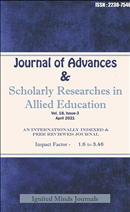Ocular Disorders among Students Attending Special Education Schools in Gurugram (India), who have Learning Difficulties with Learning
Prevalence of Ocular Disorders Among Students with Learning Difficulties in Gurugram
Keywords:
ocular disorders, students, special education schools, learning difficulties, investigate, treat, associations, perinatal histories, ophthalmologist, optometrist, social worker, intelligence quotient, visual acuity, paediatric ophthalmology, low vision centre, Chi-square test, evaluated, refractive error, strabismus, nystagmus, optic atrophy, congenital anomalies, abnormality, glasses, history of perinatal insult, family history, epilepsy, Down syndrome, cerebral palsy, visionAbstract
The purpose of this research was to investigate and treat ocular disorders in children withlearning disabilities (cLDs), as well as investigate possible associations between these conditions and thechildren's perinatal histories.In 2019, children with learning disabilities (cLDs) who were enrolled in 11different special schools were evaluated by a group that included an ophthalmologist, an optometrist,and a social worker. The students' medical histories as well as their intelligence quotient (IQ) were takeninto consideration. A comprehensive ocular examination was carried out, during which the patient'sdistant visual acuity was evaluated using either Snellen's tumbling E chart or Kay pictures. When it wasdetermined that it was necessary to do so, students were evaluated at the paediatric ophthalmology unitas well as the low vision centre. The Chi-square test was utilised for the statistical analysis of the ordinaldata that was compiled using SPSS.There were a total of 664 students who were evaluated, 526 of whom were younger than 16 years old, and323 of whom were male (61.4). The average intelligence score was 45.4, and the number of people withmoderate-to-severe learning disabilities ranged from 326 (60 percent). 143 (27.3 percent) of the childrenhad an uncorrected refractive error, followed by strabismus in 83 (15.8 percent), nystagmus in 36 (6.8percent), optic atrophy in 34 (6.5 percent), and congenital anomalies in 13 (2.5 percent). One hundred andthree children had more than one abnormality. Among the 143 students who needed glasses for theirvision, only 12 were actually wearing them. Ocular difficulties were present in a total of 132 (48.7 percent)of the children who had a history of perinatal insult. Those with a family history of epilepsy, Downsyndrome, or cerebral palsy were also more likely to suffer from ocular disorders.In this particular study,nearly half of the cLDs were found to have ocular disorders, but the vision of one quarter of them wasimproved.Published
2021-04-01
How to Cite
[1]
“Ocular Disorders among Students Attending Special Education Schools in Gurugram (India), who have Learning Difficulties with Learning: Prevalence of Ocular Disorders Among Students with Learning Difficulties in Gurugram”, JASRAE, vol. 18, no. 3, pp. 598–603, Apr. 2021, Accessed: Jul. 03, 2024. [Online]. Available: https://ignited.in/jasrae/article/view/13173
Issue
Section
Articles
How to Cite
[1]
“Ocular Disorders among Students Attending Special Education Schools in Gurugram (India), who have Learning Difficulties with Learning: Prevalence of Ocular Disorders Among Students with Learning Difficulties in Gurugram”, JASRAE, vol. 18, no. 3, pp. 598–603, Apr. 2021, Accessed: Jul. 03, 2024. [Online]. Available: https://ignited.in/jasrae/article/view/13173








